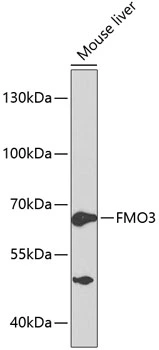
WB analysis of mouse liver tissue lysate using GTX55626 FMO3 antibody. Dilution : 1:1000 Loading : 25microg per lane
FMO3 antibody
GTX55626
ApplicationsImmunoFluorescence, Western Blot, ImmunoCytoChemistry
Product group Antibodies
TargetFMO3
Overview
- SupplierGeneTex
- Product NameFMO3 antibody
- Delivery Days Customer9
- Application Supplier NoteWB: 1:500 - 1:2000. ICC/IF: 1:10 - 1:100. *Optimal dilutions/concentrations should be determined by the researcher.Not tested in other applications.
- ApplicationsImmunoFluorescence, Western Blot, ImmunoCytoChemistry
- CertificationResearch Use Only
- ClonalityPolyclonal
- ConjugateUnconjugated
- Gene ID2328
- Target nameFMO3
- Target descriptionflavin containing dimethylaniline monoxygenase 3
- Target synonymsFMOII, TMAU, dJ127D3.1, flavin-containing monooxygenase 3, FMO form 2, dimethylaniline monooxygenase [N-oxide-forming] 3, dimethylaniline oxidase 3, flavin containing monooxygenase 3, hepatic flavin-containing monooxygenase-3, trimethylamine monooxygenase
- HostRabbit
- IsotypeIgG
- Protein IDP31513
- Protein NameDimethylaniline monooxygenase [N-oxide-forming] 3
- Scientific DescriptionFlavin-containing monooxygenases (FMO) are an important class of drug-metabolizing enzymes that catalyze the NADPH-dependent oxygenation of various nitrogen-,sulfur-, and phosphorous-containing xenobiotics such as therapeutic drugs, dietary compounds, pesticides, and other foreign compounds. The human FMO gene family is composed of 5 genes and multiple pseudogenes. FMO members have distinct developmental- and tissue-specific expression patterns. The expression of this FMO3 gene, the major FMO expressed in adult liver, can vary up to 20-fold between individuals. This inter-individual variation in FMO3 expression levels is likely to have significant effects on the rate at which xenobiotics are metabolised and, therefore, is of considerable interest to the pharmaceutical industry. This transmembrane protein localizes to the endoplasmic reticulum of many tissues. Alternative splicing of this gene results in multiple transcript variants encoding different isoforms. Mutations in this gene cause the disorder trimethylaminuria (TMAu) which is characterized by the accumulation and excretion of unmetabolized trimethylamine and a distinctive body odor. In healthy individuals, trimethylamine is primarily converted to the non odorous trimethylamine N-oxide.[provided by RefSeq, Jan 2016]
- Storage Instruction-20°C or -80°C,2°C to 8°C
- UNSPSC12352203






